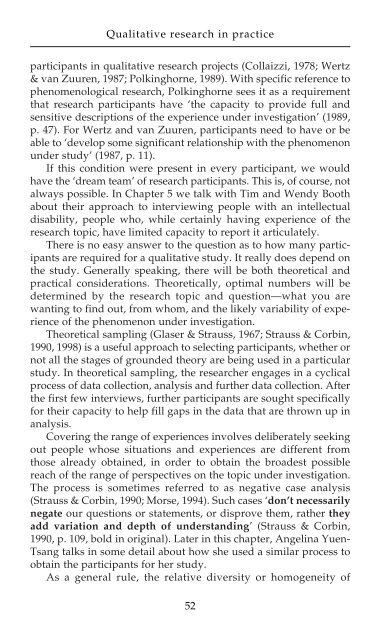Qualitative Research in Practice : Stories From the Field - Blogs Unpad
Qualitative Research in Practice : Stories From the Field - Blogs Unpad
Qualitative Research in Practice : Stories From the Field - Blogs Unpad
Create successful ePaper yourself
Turn your PDF publications into a flip-book with our unique Google optimized e-Paper software.
<strong>Qualitative</strong> research <strong>in</strong> practice<br />
participants <strong>in</strong> qualitative research projects (Collaizzi, 1978; Wertz<br />
& van Zuuren, 1987; Polk<strong>in</strong>ghorne, 1989). With specific reference to<br />
phenomenological research, Polk<strong>in</strong>ghorne sees it as a requirement<br />
that research participants have ‘<strong>the</strong> capacity to provide full and<br />
sensitive descriptions of <strong>the</strong> experience under <strong>in</strong>vestigation’ (1989,<br />
p. 47). For Wertz and van Zuuren, participants need to have or be<br />
able to ‘develop some significant relationship with <strong>the</strong> phenomenon<br />
under study’ (1987, p. 11).<br />
If this condition were present <strong>in</strong> every participant, we would<br />
have <strong>the</strong> ‘dream team’ of research participants. This is, of course, not<br />
always possible. In Chapter 5 we talk with Tim and Wendy Booth<br />
about <strong>the</strong>ir approach to <strong>in</strong>terview<strong>in</strong>g people with an <strong>in</strong>tellectual<br />
disability, people who, while certa<strong>in</strong>ly hav<strong>in</strong>g experience of <strong>the</strong><br />
research topic, have limited capacity to report it articulately.<br />
There is no easy answer to <strong>the</strong> question as to how many participants<br />
are required for a qualitative study. It really does depend on<br />
<strong>the</strong> study. Generally speak<strong>in</strong>g, <strong>the</strong>re will be both <strong>the</strong>oretical and<br />
practical considerations. Theoretically, optimal numbers will be<br />
determ<strong>in</strong>ed by <strong>the</strong> research topic and question—what you are<br />
want<strong>in</strong>g to f<strong>in</strong>d out, from whom, and <strong>the</strong> likely variability of experience<br />
of <strong>the</strong> phenomenon under <strong>in</strong>vestigation.<br />
Theoretical sampl<strong>in</strong>g (Glaser & Strauss, 1967; Strauss & Corb<strong>in</strong>,<br />
1990, 1998) is a useful approach to select<strong>in</strong>g participants, whe<strong>the</strong>r or<br />
not all <strong>the</strong> stages of grounded <strong>the</strong>ory are be<strong>in</strong>g used <strong>in</strong> a particular<br />
study. In <strong>the</strong>oretical sampl<strong>in</strong>g, <strong>the</strong> researcher engages <strong>in</strong> a cyclical<br />
process of data collection, analysis and fur<strong>the</strong>r data collection. After<br />
<strong>the</strong> first few <strong>in</strong>terviews, fur<strong>the</strong>r participants are sought specifically<br />
for <strong>the</strong>ir capacity to help fill gaps <strong>in</strong> <strong>the</strong> data that are thrown up <strong>in</strong><br />
analysis.<br />
Cover<strong>in</strong>g <strong>the</strong> range of experiences <strong>in</strong>volves deliberately seek<strong>in</strong>g<br />
out people whose situations and experiences are different from<br />
those already obta<strong>in</strong>ed, <strong>in</strong> order to obta<strong>in</strong> <strong>the</strong> broadest possible<br />
reach of <strong>the</strong> range of perspectives on <strong>the</strong> topic under <strong>in</strong>vestigation.<br />
The process is sometimes referred to as negative case analysis<br />
(Strauss & Corb<strong>in</strong>, 1990; Morse, 1994). Such cases ‘don’t necessarily<br />
negate our questions or statements, or disprove <strong>the</strong>m, ra<strong>the</strong>r <strong>the</strong>y<br />
add variation and depth of understand<strong>in</strong>g’ (Strauss & Corb<strong>in</strong>,<br />
1990, p. 109, bold <strong>in</strong> orig<strong>in</strong>al). Later <strong>in</strong> this chapter, Angel<strong>in</strong>a Yuen-<br />
Tsang talks <strong>in</strong> some detail about how she used a similar process to<br />
obta<strong>in</strong> <strong>the</strong> participants for her study.<br />
As a general rule, <strong>the</strong> relative diversity or homogeneity of<br />
52

















